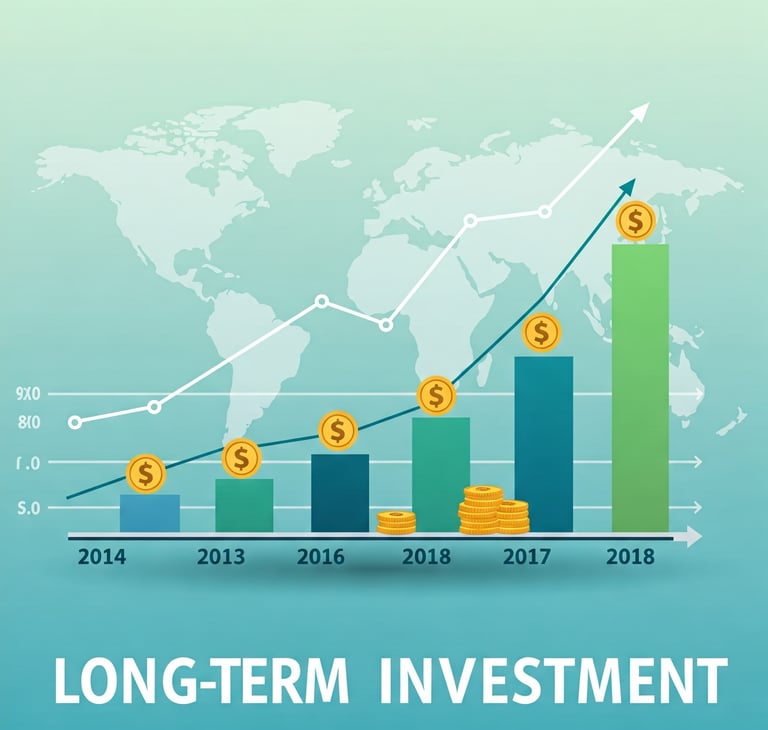

Unit-Linked Insurance Plans (ULIPs) combine insurance and investment into a single, convenient product. When you pay a premium, part of it provides life insurance coverage to protect your family, while the remainder is invested in market-linked funds. You can choose how your money is allocated—whether in equity funds for higher growth, debt funds for steadier returns, or a balanced mix based on your risk tolerance and financial goals. The returns from ULIPs depend on the performance of these underlying investments, allowing your wealth to grow with the market. ULIPs also offer flexibility to switch between different fund types as your objectives or market conditions change. Additionally, a mandatory lock-in period encourages a long-term investment approach, helping you stay focused on your financial goals rather than short-term market fluctuations. This combination of protection, growth potential, and flexibility makes ULIPs an attractive option for those seeking both insurance and investment benefits.
Unit Linked Insurance Plans (ULIPs)
Key Features & Benefits of ULIPs
Investment and Insurance


Unit Linked Insurance Plans (ULIPs) are financial products that combine investment opportunities with life insurance coverage. When you pay the premium for a ULIP, a portion goes toward providing life insurance, while the rest is invested in market-linked funds such as equities, debt instruments, or a balanced mix of both. ULIPs offer flexibility, allowing you to switch between different funds based on your risk appetite and financial goals. They also provide tax benefits under Sections 80C and 10(10D) of the Income Tax Act, making them a tax-efficient investment option. With a mandatory five-year lock-in period, ULIPs encourage disciplined saving and long-term wealth accumulation, making them well-suited for achieving important financial objectives like retirement planning and funding education.
Flexibility


Unit Linked Insurance Plans (ULIPs) offer investors considerable flexibility by allowing them to switch between different fund options, such as equity and debt, based on their risk appetite and market conditions. Premium payments can be made monthly, quarterly, or annually, depending on what suits your financial situation. After the mandatory five-year lock-in period, you have the option to make partial withdrawals if needed. ULIPs also let you adjust your life insurance coverage and investment allocation as your needs change over time. This flexibility enables investors to maximize returns while maintaining insurance protection, making ULIPs an ideal choice for those looking to balance growth and security in their financial planning.
Partial Withdrawals


Unit Linked Insurance Plans (ULIPs) give policyholders the option to make partial withdrawals from their invested funds after completing the mandatory five-year lock-in period. This feature is particularly useful for meeting urgent financial needs, such as emergencies, education expenses, or other unforeseen costs, without having to surrender the entire policy or lose insurance coverage. Typically, insurers allow you to withdraw a certain percentage of your fund value—often up to 10% or 25%—depending on their specific rules. However, it’s important to note that making partial withdrawals can reduce the sum assured, which is the amount your beneficiaries would receive if something were to happen to you. There may also be limits on how many withdrawals you can make in a year, and some insurers might charge fees for these transactions. While partial withdrawals provide valuable flexibility, it’s wise to use this option sparingly to avoid negatively impacting your long-term investment growth and insurance benefits.
Tax Benefits


Unit Unit-linked insurance Plans (ULIPs) come with attractive tax benefits under the Income Tax Act of 1961. Under Section 80C, premiums paid for ULIPs qualify for a deduction of up to ₹1.5 lakh annually, helping reduce your taxable income. The maturity proceeds or death benefits from ULIPs are exempt from tax under Section 10(10D), provided certain conditions are met—such as the premium not exceeding 10% of the sum assured. Additionally, partial withdrawals made after the mandatory five-year lock-in period are also tax-free.
Long-Term Investment


ULIPs, or unit-linked insurance plans, are specifically designed for long-term investment horizons, typically recommended for at least 10 to 15 years. By staying invested over a longer period, you benefit from the power of compounding, where your returns are reinvested and can grow significantly over time. This long-term approach also helps you ride out market volatility and increases your chances of earning higher returns compared to short-term investments. Regular premium payments not only ensure continuous life insurance coverage but also encourage disciplined saving habits. Investing in ULIPs for the long term can help you achieve major financial goals, such as building a retirement corpus or funding your children’s education, while also providing essential protection for your loved ones.
Drawbacks of ULIPs
Market Volatility


Investing in Unit Linked Insurance Plans (ULIPs) requires careful consideration of market volatility, as their value fluctuates with market conditions due to investments in equity and debt funds. This means your investment may decline during market downturns, potentially leading to losses. However, ULIPs offer the flexibility of fund switching, allowing you to move your investments between different fund types, such as shifting from equities to debt during volatile periods or vice versa when markets are favorable. This feature helps you manage risk and adapt to changing market environments. Additionally, the mandatory five-year lock-in period promotes a long-term investment approach, enabling you to benefit from potential market recoveries and the power of compounding while weathering short-term fluctuations.
High Charges


Unit-linked insurance Plans (ULIPs) often come with several high charges that can impact your overall returns. When you purchase a ULIP, a portion of your premium is deducted to cover various fees, such as premium allocation charges, which pay for initial expenses like commissions and underwriting. In addition to these upfront costs, there are ongoing charges, including mortality charges for life insurance coverage, policy administration fees for managing your policy, and fund management fees for handling your investments. These fees collectively reduce the actual amount invested in market-linked funds, especially during the early years of the policy. While the Insurance Regulatory and Development Authority of India (IRDAI) has set limits on these charges, they can still be significant and affect the growth of your investment.
Complexity


Unit-Linked Insurance Plans (ULIPs) can be confusing for some investors because of their complex structure, which combines both market-linked investments and life insurance coverage. To make informed decisions, it’s important to understand how both the investment and insurance components work together. The cost structure of ULIPs adds another layer of complexity, with various charges such as mortality charges, fund management fees, and premium allocation costs that can affect your returns. Additionally, the need to choose from a range of investment funds and actively manage these options can be overwhelming, especially for those who are not familiar with financial markets. Given these complexities, it’s essential for prospective investors to thoroughly research and fully understand ULIPs, including their risks and benefits, before committing to an investment.
Lock in Period


If a policyholder decides to surrender their Unit Linked Insurance Plan (ULIP) before the five-year lock-in period ends, they will incur surrender charges, and the remaining fund value will be transferred to a Discontinued Policy Fund (DP Fund). In this fund, the amount earns a minimum guaranteed interest of 4% per annum until the lock-in period expires. During this time, the policyholder loses access to the funds, and the life insurance coverage under the policy ceases immediately upon surrender. However, after the lock-in period of five years, policyholders have greater flexibility—they can surrender their ULIP or make partial withdrawals without facing any penalties.
Ways to Invest in ULIPs
Choose The Right Plan


Selecting the right Unit Linked Insurance Plan (ULIP) is essential to achieving your financial objectives. Begin by clearly identifying your goals, whether they involve building wealth, funding education, or saving for retirement. Look for a ULIP that offers a diverse range of investment options, such as debt funds for stability or equity funds for higher growth potential, so you can tailor your portfolio according to your risk appetite. Ensure the insurance coverage provided by the plan is adequate for your needs. It’s also important to review the fee structure, as charges like fund management fees and premium allocation charges can impact your overall returns. By choosing a ULIP that matches your financial goals and risk tolerance, you can maximize your investment growth while ensuring sufficient life insurance protection.
Decide Your Premium Amount


When investing in a Unit Linked Insurance Plan (ULIP), it’s important to set your premium amount thoughtfully, keeping your budget and financial goals in mind. ULIPs provide flexible payment options, allowing you to pay premiums monthly, quarterly, semi-annually, or annually based on what suits your financial situation. Finding the right balance is key: your premium should be affordable without putting pressure on your finances, yet substantial enough to help you meet your investment objectives and secure adequate insurance coverage. While higher premiums may lead to greater potential returns over time, they should always be chosen in line with your overall financial capacity. Selecting a premium that aligns with both your budget and goals will help you maximize the benefits of your ULIP investment while maintaining essential life insurance protection.
Select Funds Based on Risk


When selecting a ULIP fund, it’s important to choose one that aligns with your risk tolerance and financial goals. Equity funds are suitable for those comfortable with higher risk, as they offer the potential for significant growth and returns but can be volatile. Debt funds, on the other hand, focus on stability and lower risk, providing steady but modest returns through fixed-income investments. Hybrid funds offer a middle ground by combining both equity and debt components, resulting in moderate risk and balanced returns. By understanding your investment objectives and assessing your comfort with risk, you can select the ULIP fund type that best supports your financial aspirations.
Monitor and Switch Funds


To maximize the returns from your Unit Linked Insurance Plan (ULIP), it is important to regularly monitor your fund’s performance and make timely switches when necessary. Use tools like a ULIP calculator to track your investment growth and assess whether your funds are aligned with your financial goals. If a fund is underperforming or market conditions shift, consider switching to a more appropriate fund to better suit your needs. Many ULIPs allow free fund switches annually, enabling you to adjust your portfolio without additional costs. By staying proactive and making strategic fund changes, you can effectively manage risks, respond to market changes, and enhance the overall performance of your ULIP investment.
Stay Invested Long-Term


To maximize your wealth through a Unit Linked Insurance Plan (ULIP), it’s best to stay invested for the long term, well beyond the mandatory five-year lock-in period. Remaining invested allows you to benefit from the power of compounding and gives your investments time to recover from short-term market fluctuations. Avoid making premature withdrawals, as they can reduce your overall returns and disrupt the growth of your investment. Adopting a long-term approach not only optimizes your ULIP’s performance but also helps secure your financial future by building a substantial corpus over time.
